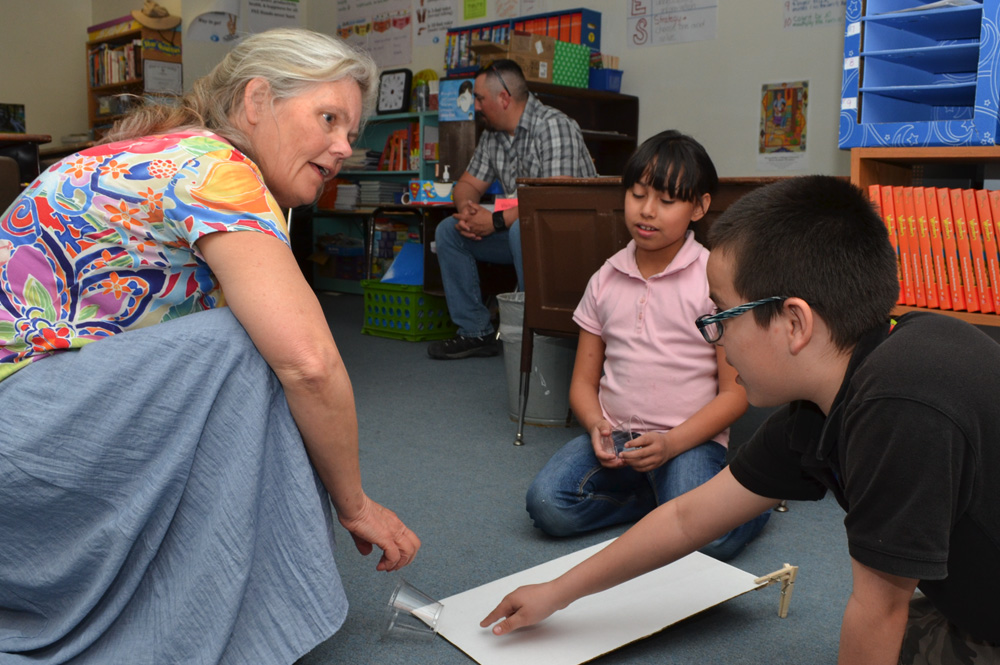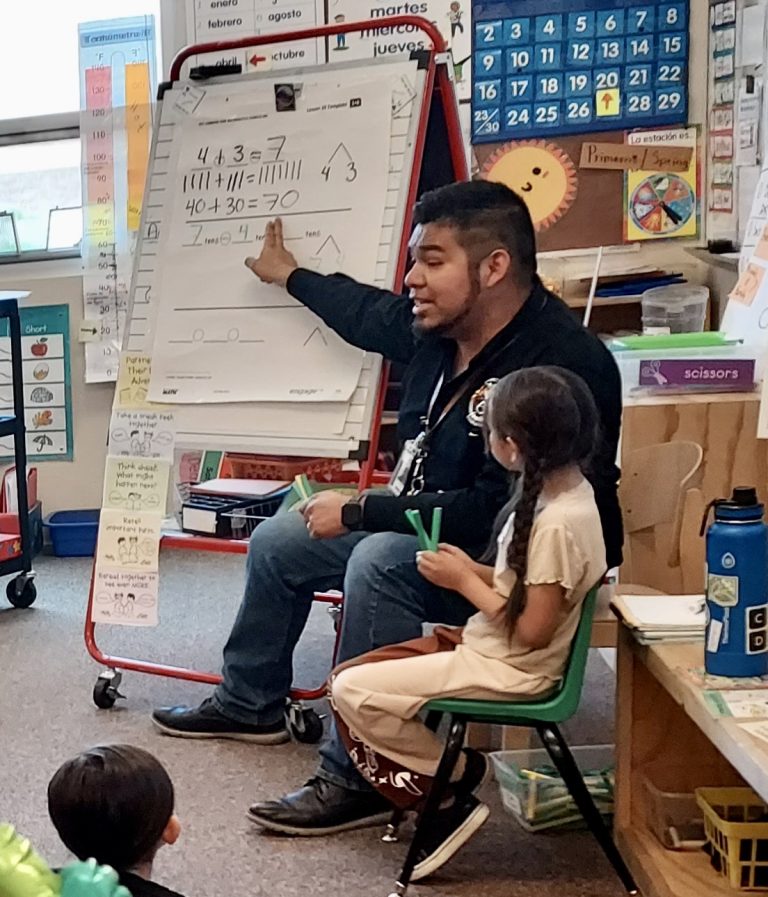The Inquiry Science Education Consortium offers grade-specific STEM teaching and learning opportunities at the elementary school level. Complex science and engineering concepts are broken down into engaging activities with hands-on and minds-on lessons that link together various domains of science.
Newton’s First Law of motion states that an object will remain at rest or in uniform motion in a straight line unless acted upon by an external force. In third grade, as part of the Motion and Matter module, this idea is explored by pulling and pushing objects using force.
“What rules can predict where a rolling cup will go?” Rebecca DeLair, third grade teacher at Abiquiú Elementary, asks her class as they read the focus question she has written on the board, then record it in their science notebooks.
With this question mind, the class discusses the wheel and axle system they made and explored in an earlier lesson. They recalled that two wheels the same size connected at the centers by an axel rolled straight down a ramp. They made other variations to the system with wheels of different sizes, adding a third wheel the same or different size, and attaching the axel in a different hole on the wheels outside of the center.
“What about when we made a change to the size of one of the wheels? What was different? Tell me which way it rolled,” Ms. DeLair asked.
“It went to the side.”
“The big wheel turned toward the little wheel,” said the third grade scientists.
In this next lesson, the class explores a similar kind of system, but instead of wheels and an axel, they use cups. Ms. DeLair holds up one a cup and points to the two circles: the open circle at the top and the smaller circle at the bottom, noting the similarity to the two different size wheels from the axle system in the prior lesson.
In all ISEC modules, the Next Generation Science Standards (NGSS) are apparent throughout lessons and among grades. Crosscutting Concepts (CCCs), one of the three dimensions of NGSS, have broad importance across multiple sciences and provide key tools for understanding or investigating complex ideas and solving problems. In this lesson, students learn that patterns of an object’s motion can be observed and measured in different situations. Regular patterns in an object’s motion can also be used to predict future motion.
In addition to observing and predicting these patterns, other CCCs in Motion and Matter lessons include cause and effect, systems and systems models, energy and matter, and scale, proportion, and quantity.
“If we roll this cup down a ramp, what do you think is going to happen? What are your predictions?” asks Ms. DeLair.
The scientists shout out their answers. “The cup is going to lean when it rolls.”
“It’s going to go to the side like the two different wheels.
In partners, the students gather supplies: two plastic cups, four clothespins, and one piece of cardboard to build a ramp. They test their predictions by rolling a cup down the slope and reporting on their observations.
“Wow, that went far and made a big curve.”
“The cup went to the little side and rolled off the edge.”
Now, knowing the movement of the cup on the ramp, Ms. DeLair asks the class to predict where the cup will end up and see if they can park it behind the top of the ramp. To achieve the goal, the scientists have to find the right spot for the cup’s starting point on the ramp. They observed that the cup rolled and turned in a predictable way but sometimes also slid down the ramp. If the cup curves around and hits the ground too soon off the side of the ramp, it stops early and doesn’t get all the way around.
“Does anyone remember what makes the cup stop moving?”
“Friction!”
Ms. DeLair then challenges the class to think with their partners about different ways they could put two cups together with new supplies—tape and four pennies—and predict how the cup systems would roll. In the true spirit of teamwork, the partners plan their design and while one student held the cups the other taped them together.
Some teams attached the open ends together, while others connected the two bottoms. Next they rolled the configurations down the ramp and observed what happened.
In the two-cup system, when the bigger open ends of the cups faced outward, the system rolled straight, just like the same size wheels on an axel. When the open ends were taped together, the system went “wabble, wabble” and rolled from side to side like the three-wheel system with a larger one in the center.
Next, they added the pennies, which some left loose inside the closed system and others taped to parts of the cups. They observed the changes in rolling movement.
Ms. DeLair encouraged deep inspection. “What do you notice when it rolls this time? Watch it, what’s it doing?” The observation varied.
“The weight of the pennies make it stop.”
“The pennies are making it slow down.”
“It looks like it slows down then speeds up then slows and speeds, like “womp, womp.”
“Every time it gets to the penny side, it stops for a little bit and keeps going. It limps.”
“The pennies make it go farther.”
The teams created a different system. One team taped the top of one cup to the side of another. Before they sent it down the ramp, they predicted the outcome. “I think it’s going to roll weirdly, to the side.”
“It’s harder to roll. The different sides make it stop,” the team noticed upon testing.
Toward the end of the lesson, the teams were asked to bring their favorite design to the carpet. The class sat together in a meaning making circle, shared their cup system, and explained how it rolls. They compared their designs to similar wheel and axle systems and talked about patterns in movement. They also tried to define the how the placement of the pennies affected the way each system rolled.
“Do the pennies make it heavier and slow? When does it roll farther with the pennies?”
The cups that were connected sideways were less predictable but did show a pattern, turning to one side, then turning back to the other side, similar to a big wheel and a small wheel, but didn’t go very far. Setting this system on the ramp in different ways also changed its movement.
From the previous lesson, the class knew that any change in motion requires a force, a push or a pull, that has both strength and a direction.
“When something doesn’t move, what is it called?” asked Ms. DeLair.
“It’s balanced!”
“Yes, the object has balanced forces. Friction is also a force that can cause an object to stop moving, but it’s not something you can see. Gravity is also a force,” she added.
Going back to the focus question, the scientists talked about the rules that make the cup move in different ways. Systems with the same size wheels roll straight. Different size wheels make the system roll on a curved path. Friction makes the rolling stop. The weight of the pennies changes the system’s direction or speed.
The following class will be a review, and then students will write their findings in their notebooks with a model illustration. In a later engineering exploration, they will make a cart following specific parameters, continuing to draw upon knowledge from these lessons.
Science lessons may be incorporated into mathematics, English language arts, and social studies classes for rigorous applications and extended learning. This class is unique in that Ms. DeLair combines science with Spanish class and co-teaches with Spanish teacher Melissa Martinez, who helps students by translating vocabulary and teaching in both languages.
Ms. Martinez likes science due to the richness of the discussions but says it’s also challenging. “There are some words that I’m learning too,” she said. “It’s good for kids to see that adults learn new things.”
Ms. DeLair sees the value in inquiry teaching and learning with the hands-on explorations. “If I were to stand in the front of this class and say, ‘boys and girls, if I put the cup like this, it’s going to go wonky down the ramp, and if I put the cup like this, it rolls straight,’ they would know nothing. It would go in one ear and out the other. The fact that they could manipulate the cups in any way they want and tape the pennies, they made discoveries. As adults, we still make discoveries.”
As the ISEC Teacher Leader in her school, Ms. DeLair helps to facilitate discoveries and answer questions in her class and among her fellow teachers. The Teacher Leader Cadre, or TLC as the group is lovingly called, builds leadership in the education profession and creates a support system at each ISEC school throughout the year.



